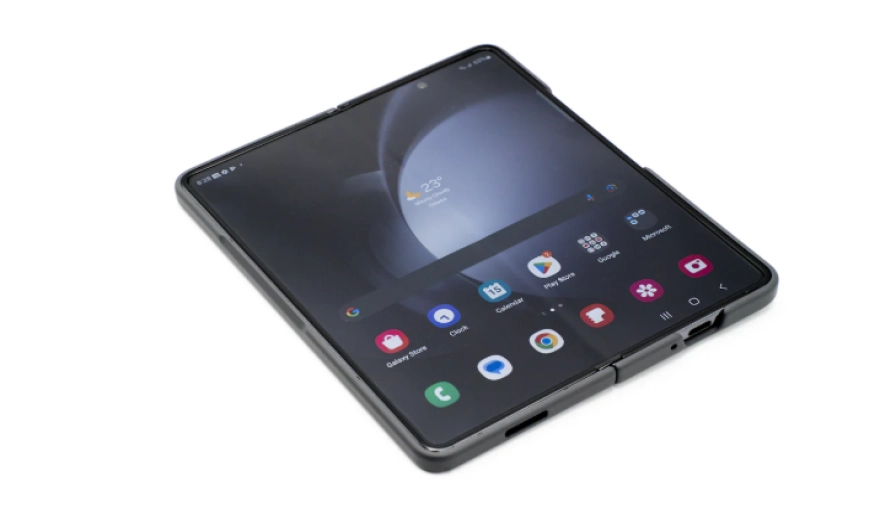Are Foldable Phones Shaping the Next Era of Smartphones
27 min read Foldable phones are changing how you think about smartphones. They combine portability with innovation, offering features that traditional devices can’t match. Imagine carrying a compact phone that unfolds into a tablet-like screen. This design isn’t just stylish—it’s practical. You can multitask with ease, splitting the screen to run multiple apps or enjoy an immersive gaming experience.written by Sophia Reynolds, Content Creator May 21, 2024 05:50
Image Source: pexels
Foldable phones are changing how you think about smartphones. They combine portability with innovation, offering features that traditional devices can’t match. Imagine carrying a compact phone that unfolds into a tablet-like screen. This design isn’t just stylish—it’s practical. You can multitask with ease, splitting the screen to run multiple apps or enjoy an immersive gaming experience.
The market for foldable phones is growing fast. In 2023, it was valued at $27.79 billion and is expected to hit $74.16 billion by 2030. While traditional smartphones still dominate, foldable devices are gaining ground. Their unique features and futuristic appeal make them a glimpse into the future of foldable phones.
Key Takeaways
- Foldable phones help with multitasking by having bigger screens. Users can use many apps at once, making work easier.
- These phones are easy to carry and very useful. They fit in pockets but open up like a tablet for more space.
- Foldable phones have cool designs that look unique. They can be changed to match what different users like.
- Even with great features, foldable phones have problems. They cost a lot and might not last long, which could stop people from buying them.
- Foldable phones have a bright future as tech improves. More companies, like Apple, might start making them too.
What Makes Foldable Phones Unique
Multitasking Capabilities
Enhanced productivity with split-screen functionality
Foldable phones redefine multitasking. When unfolded, their larger screens let you manage multiple apps at once. You can reply to emails while watching a video or navigate maps while jotting down notes. Traditional smartphones, with their smaller screens, just can’t match this level of efficiency.
Here’s what makes foldable phones stand out:
- You can open multiple apps side by side.
- Tasks like comparing prices across shopping apps or checking stock updates become seamless.
- The larger display allows you to handle secondary tasks, like replying to messages during video calls, without breaking a sweat.
Seamless transitions between folded and unfolded modes
Portability and Versatility
Compact design for easy carrying
Foldable phones combine portability with functionality. When folded, they fit snugly in your pocket or bag, making them as convenient as traditional smartphones. Yet, they unfold into a larger screen, giving you the best of both worlds.
Larger screen real estate for immersive experiences
The versatility of foldable phones shines in different scenarios. Whether you’re gaming, streaming movies, or reading, the larger display offers an immersive experience. It’s like carrying a tablet and a phone in one device. This adaptability makes foldable phones perfect for users who want flexibility without sacrificing portability.
Design Appeal
Cutting-edge aesthetics that stand out in the market
Foldable phones don’t just perform well—they look amazing too. Their futuristic designs grab attention and showcase innovation. Brands like Samsung and Huawei have turned these devices into symbols of modern technology, blending style with functionality.
Customizable form factors for diverse user needs
Foldable phones adapt to your lifestyle. Whether you prefer a flip-style design or a book-like fold, there’s a model for you. This customization ensures that foldable phones cater to a wide range of preferences, making them more than just a gadget—they’re a statement.
The future of foldable phones looks bright. With their multitasking capabilities, portability, and sleek designs, they’re setting new standards in mobile technology.
Challenges and Limitations
Durability Concerns
Fragility of foldable screens and hinges
Foldable phones look sleek, but their durability raises eyebrows. The folding screens and hinge mechanisms are complex and prone to damage. You might worry about scratches, cracks, or even dust getting into the hinges. These concerns make foldable phones feel fragile, which can shake your confidence in their longevity. Plus, repairing these devices isn’t cheap or easy, adding another layer of hesitation for potential buyers.
Susceptibility to wear and tear over time
Daily use can take a toll on foldable phones. Folding and unfolding the screen repeatedly can lead to visible creases or even mechanical failures. Over time, this wear and tear might make you question whether the investment was worth it. For many, the idea of a phone that doesn’t age well is a dealbreaker.
High Costs
Premium pricing compared to traditional smartphones
Foldable phones come with a hefty price tag. Let’s compare:
For example, the Samsung Galaxy Z Fold 6 starts at $1,900, while the Google Pixel Fold costs around $1,799. These prices reflect the advanced technology and materials used, but they also limit accessibility. Most people can’t justify spending over $1,500 on a phone, no matter how innovative it is.
Limited affordability for the average consumer
The high cost of foldable phones makes them a luxury item. Factors like flexible OLED displays and specialized manufacturing drive up prices. While these devices showcase cutting-edge innovation, their exclusivity keeps them out of reach for many. This pricing barrier slows down their adoption and keeps them from becoming mainstream.
Software and App Optimization
Lack of widespread app support for foldable displays
Foldable phones offer unique features, but apps often fail to keep up. Developers face challenges like ensuring seamless transitions between folded and unfolded modes or supporting multi-window functionality. Without optimized apps, you might struggle with inconsistent layouts or limited multitasking capabilities.
Challenges in creating seamless user experiences
The lack of app optimization can make foldable phones feel incomplete. Imagine trying to use an app that doesn’t adapt to the larger screen—it’s frustrating. Developers need to test apps across various screen sizes and orientations, but this process takes time. Until more apps are optimized, the user experience on foldable phones will remain a mixed bag.
Despite these challenges, the future of foldable phones holds promise. As technology advances and prices become more competitive, these devices could redefine how we use smartphones.
The Future of Foldable Phones

Image Source: pexels
Advancements in Technology
Development of more durable materials and hinges
Foldable phones are becoming tougher with each new model. Manufacturers are using ultra-thin glass (UTG) to make screens more flexible and resistant to scratches. Samsung has been a leader in this area, incorporating UTG into its Galaxy Z series. Companies like Oppo and Xiaomi are also stepping up. Oppo’s Find N3 uses a "Flexion Hinge" that folds flat without leaving a gap, while Xiaomi’s Mix Fold 3 features a "Micro Waterdrop Hinge" to reduce creases and block dust. Apple is rumored to be working on a hinge design that reduces stress on the display, which could set a new standard for durability.
Improved battery life and performance for foldable devices
Battery life is another area where foldable phones are improving. You’ll see advancements in battery technology that allow for longer usage times without making the device bulky. Manufacturers are also optimizing performance, ensuring foldable phones can handle multitasking and gaming without draining the battery too quickly. These improvements make the future of foldable phones even more exciting.
Market Trends and Adoption
Increasing competition among manufacturers driving innovation
The foldable phone market is heating up, and that’s great news for you. Competition among brands like Samsung, Huawei, and Google is driving innovation. This means better designs, improved features, and more competitive pricing. For example:
Growing consumer interest and adoption rates
Consumer interest in foldable phones is skyrocketing. The market was valued at $27.79 billion in 2023 and is projected to reach $74.16 billion by 2030. People love the versatility of switching between a compact phone and a tablet-sized screen. Whether you’re into gaming, streaming, or multitasking, foldable phones offer something unique.
Potential New Players
Speculation about Apple entering the foldable phone market
Apple might join the foldable phone race soon, and that could change everything. Rumors suggest Apple is developing a foldable iPhone with improved hinge technology and better battery efficiency. If Apple enters the market, it could blur the lines between smartphones and tablets, possibly impacting future iPad designs. Apple’s reputation for innovation might also push competitors to step up their game.
Impact of new entrants on the foldable phone ecosystem
New players like Apple could shake up the foldable phone ecosystem. Their entry might lead to more foldable-optimized apps, thanks to Apple’s extensive developer network. You could also see innovations like rollable or slidable displays becoming mainstream. As competition grows, prices might drop, making foldable phones accessible to more people. The future of foldable phones looks brighter than ever.
Foldable phones are redefining what smartphones can do. They give you multitasking power, portability, and a futuristic design that stands out. Sure, challenges like durability and cost exist, but the rapid pace of innovation is closing those gaps. With brands like Samsung and Huawei leading the charge and others like Apple rumored to join, the future of foldable phones looks promising. As prices drop and technology improves, these devices could become the new standard. If you love cutting-edge tech, foldable phones might just be your next big upgrade.
FAQ
What are foldable phones, and how do they work?
Foldable phones are smartphones with flexible screens that fold and unfold. They use advanced materials like ultra-thin glass and hinge mechanisms to switch between compact and larger screen modes. This lets you enjoy portability and a tablet-like experience in one device.
Are foldable phones durable enough for daily use?
Foldable phones are improving in durability, but they still require care. Manufacturers are using stronger materials and better hinges. However, you should avoid dropping them or exposing them to dust and water. Treat them like a premium gadget to ensure they last.
Why are foldable phones so expensive?
Foldable phones cost more because of their cutting-edge technology. Flexible OLED displays, advanced hinges, and specialized manufacturing drive up prices. As competition grows and production scales up, prices may drop, making them more affordable in the future.
Do all apps work well on foldable phones?
Not all apps are optimized for foldable screens yet. Some may not adapt perfectly to the larger display or multi-window features. Developers are working on improving app compatibility, so you can expect better support as foldable phones become more popular.
Should you buy a foldable phone now or wait?
If you love trying new tech and multitasking, go for it. Foldable phones offer unique features. But if you’re worried about durability or cost, waiting for future models with better materials and lower prices might be a smarter choic



















